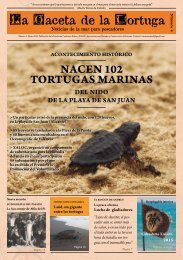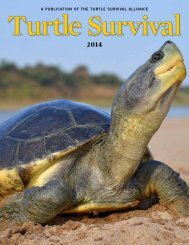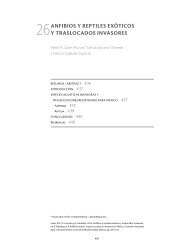tsrp63entire
tsrp63entire
tsrp63entire
Create successful ePaper yourself
Turn your PDF publications into a flip-book with our unique Google optimized e-Paper software.
Action Accountability Priority<br />
4.1 Review the outcomes of all native frog<br />
translocations and make recommendations on<br />
whether supplementation or rescue is required<br />
by 2015.<br />
4.2 Supplement or rescue translocated populations as<br />
required according to the results of the review in<br />
Action 4.1 by 2015.<br />
4.3 Monitor translocations over an appropriate<br />
timeframe to measure their success throughout and<br />
beyond the term of this plan.<br />
4.4 Select suitable sites for the potential establishment<br />
of new native frog populations through translocation<br />
for each species by 2017.<br />
4.5 Establish a predator-free island or site for<br />
establishing a new Archey’s frog population by<br />
2016; plan the translocation and implement<br />
by 2018.<br />
4.6 Identify a predator-managed site for establishing a<br />
new Maud Island frog population by 2016; plan the<br />
translocation and implement by 2018.<br />
Recovery Group<br />
Relevant Conservation Services Group staff<br />
Relevant Conservation Services Group staff<br />
Relevant Conservation Services Group staff<br />
Recovery Group<br />
Recovery Group<br />
Relevant Conservation Services Group staff<br />
Recovery Group<br />
Relevant Conservation Services Group staff<br />
Essential<br />
Essential<br />
Essential<br />
Essential<br />
Essential<br />
High<br />
5.1.5 Topic 5—Captive management<br />
The maintenance and establishment of healthy ex situ populations can play an important role in<br />
the long-term conservation of native frogs. Although the ultimate aim of this plan is to recover<br />
native frog populations in the wild, captive management could provide insurance populations<br />
in case of catastrophic declines in the wild, and captive rearing programmes could provide<br />
stock for re-introductions and/or translocations. Therefore, ex situ conservation action should<br />
be considered as a management tool for all native frog species, as recommended by The Global<br />
Amphibian Assessment (IUCN et al. 2006).<br />
During the term of this plan, ex situ and captive management will be used to:<br />
••<br />
Develop and refine captive husbandry techniques<br />
••<br />
Help secure from extinction the most threatened taxa and ESUs<br />
••<br />
Advocate for all native frog species and their conservation<br />
Captive management currently occurs for both Archey’s frog (Auckland Zoo) and Hochstetter’s<br />
frog (Hamilton Zoo), and is planned for Maud Island frog (Orana Wildlife Park). This<br />
management is coordinated through the Recovery Group via captive institutions and is<br />
supported by the professional association of captive institutions (the Zoo and Aquarium<br />
Association). Small populations of Hochstetter’s frog and Maud Island frog are also held at the<br />
Department of Zoology, University of Otago.<br />
Many issues are relevant to the captive management of native frogs, including diverse specialist<br />
topics (e.g. disease management, husbandry techniques, small population management) that are<br />
best managed through close collaboration with captive holders and universities. The strategic<br />
direction for the captive management of native frogs as part of the wider native frog recovery<br />
effort needs to be more strongly developed and promoted by publishing a native frog captive<br />
management plan. This plan should not only address future directions, but also assess past<br />
learning, including the development of understanding around metabolic bone disease (MBD),<br />
which had detrimental effects on many of our native frogs due to misunderstandings regarding<br />
the amount of light that was required by individuals in captivity. The sharing of this knowledge<br />
and consistent management of captive populations at a national level is essential for native<br />
frog recovery. Publication of the native frog captive management plan will comply with the<br />
requirements of DOC’s Captive Management Standard Operating Procedure (McInnes, 2008).<br />
18 Bishop et al.—Native frog recovery plan, 2013–2018





